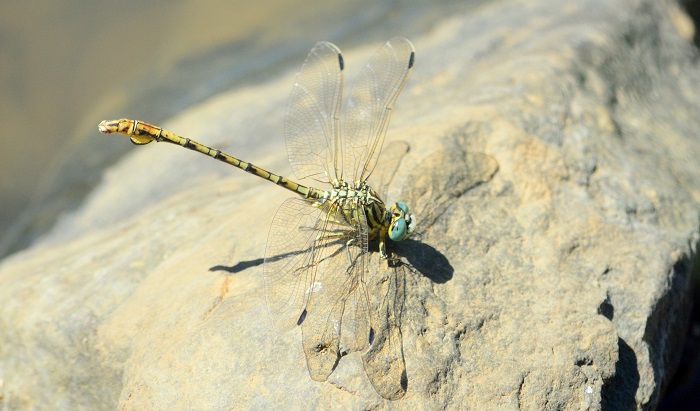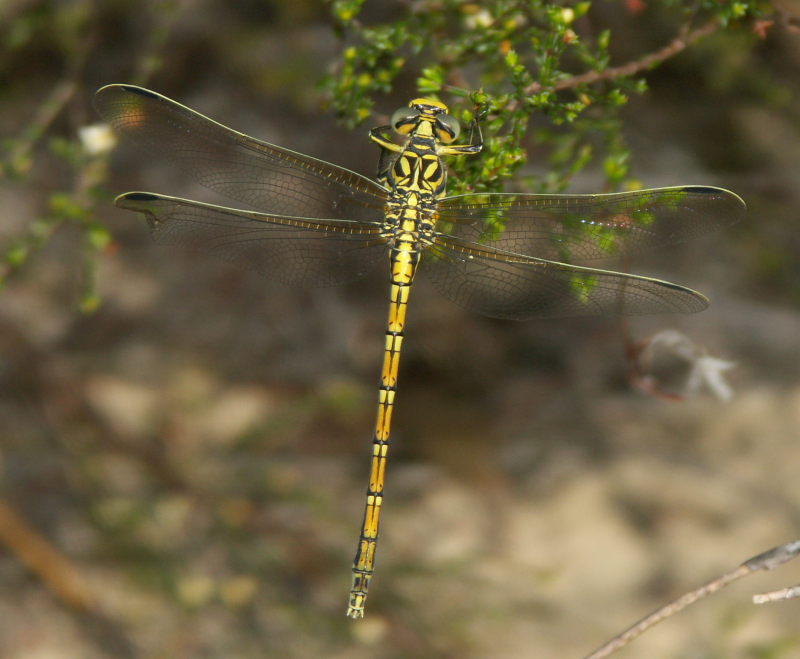Cover photo by Chris Willis.
Find the Common Thorntail in the FBIS database (Freshwater Biodiversity Information System) here.
Family Gomphidae
Identification

Mkuze River, KwaZulu-Natal
Photo by Ryan Tippett
Inset by Gregg Darling
Medium-large size
Length up to 53mm; Wingspan attains 69mm.
The Common Thorntail is most similar to the Cape Thorntail (Ceratogomphus triceraticus), but is smaller and paler. Ceratogomphus pictus has thin black edging on the abdomen foliations, compared to the thick black border found on Ceratogomphus triceraticus. In addition, C. pictus has a small, thin, forward-projecting spine at the top of segment ten. In C. triceraticus this spine is broad.
The sexes are similar but females are more robust and have broader abdomens with smaller foliations.
Click here for more details on identification of the Common Thorntail.

Paardeberg, Western Cape
Photo by Ryan Tippett
Habitat
The Common Thorntail inhabits both still and running water habitats, including streams, rivers, and dams. It prefers open and exposed areas with bare ground and rocks. The Common Thorntail is found in all the biomes of South Africa, although it is scarce in the Succulent Karoo and Nama Karoo. It occurs up to 1200m above sea level.

Photo by Ryan Tippett
Behaviour
The Common Thorntail often perches on bare ground or rocks close to the water. It sometimes also sits on low twigs or bushes along the banks. The Common Thorntail hunts from a perch and has a fast, powerful flight. Non-breeding individuals, especially females, may be found some distance from water.
The Common Thorntail is active from late September to late April (See phenology below).

Elands River, KwaZulu-Natal
Photo by Ryan Tippett
Status and Conservation
The Common Thorntail is common and widespread in southern Africa. It is listed as of Least Concern in the IUCN Red List of Threatened Species. The Common Thorntail readily utilises man-made habitats such as farm dams and is often present along the eroded or overgrazed margins of water-bodies.

Amakhosi Game Reserve, KwaZulu-Natal
Photo by Ryan Tippett
Distribution
Ceratogomphus pictus is a Southern African species extending from South Africa through Namibia, Botswana, and Zimbabwe to southern Zambia. It is widespread in South Africa but is mostly absent from the humid lowveld and coastal parts of north-eastern KwaZulu-Natal. The Common Thorntail is also absent from most of the Karoo but is present along the middle Orange River.

Mkuze River, KwaZulu-Natal
Photo by Ryan Tippett
Below is a map showing the distribution of records for Common Thorntail in the OdonataMAP database as at February 2020.

Below is a map showing the distribution of records for Common Thorntail in the OdonataMAP database as of December 2024.

The next map below is an imputed map, produced by an interpolation algorithm, which attempts to generate a full distribution map from the partial information in the map above. This map will be improved by the submission of records to the OdonataMAP section of the Virtual Museum.


Ultimately, we will produce a series of maps for all the odonata species in the region. The current algorithm is a new algorithm. The objective is mainly to produce “smoothed” maps that could go into a field guide for odonata. This basic version of the algorithm (as mapped above) does not make use of “explanatory variables” (e.g. altitude, terrain roughness, presence of freshwater — we will be producing maps that take these variables into account soon). Currently, it only makes use of the OdonataMAP records for the species being mapped, as well as all the other records of all other species. The basic maps are “optimistic” and will generally show ranges to be larger than what they probably are.
These maps use the data in the OdonataMAP section of the Virtual Museum, and also the database assembled by the previous JRS funded project, which was led by Professor Michael Samways and Dr KD Dijkstra.

iXopo district, KwaZulu-Natal
Photo by Ryan Tippett
Phenology



Amakhosi Game Reserve, KwaZulu-Natal
Photo by Ryan Tippett
Further Resources
The use of photographs by Christopher Willis and Gregg Darling is acknowledged. Other photos by Ryan Tippett.
Common Thorntail Ceratogomphus pictus Hagen, 1854
Other Common Names: Gewone Doringstert (Afrikaans)
Recommended citation format: Loftie-Eaton M; Navarro R; Tippett RM; Underhill L. 2025. Common Thorntail Ceratogomphus pictus. Biodiversity and Development Institute. Available online at https://thebdi.org/2020/05/26/common-thorntail-ceratogomphus-pictus/
References: Tarboton, M; Tarboton, W. (2019). A Guide to the Dragonflies & Damselflies of South Africa. Struik Nature.
Samways, MJ. (2008). Dragonflies and Damselflies of South Africa. Pensoft
Samways, MJ. (2016). Manual of Freshwater Assessment for South Africa: Dragonfly Biotic Index. Suricata 2. South African National Biodiversity Institute, Pretoria
Martens, A; Suhling, F. (2007). Dragonflies and Damselflies of Namibia. Gamsberg Macmillan.

Mkuze River, KwaZulu-Natal
Photo by Ryan Tippett

